Fields emerging that need the catalysis platinum group metals can provide

SFA Oxford CEO Henk de Hoop interviewed by Mining Weekly's Martin Creamer. Video: Darlene Creamer.
JOHANNESBURG (miningweekly.com) – A wide range of industries, which require considerable production volumes that platinum group metals (PGMs) can help to provide, are being developed and ramped up, such as in the production of ammonia, methanol or e-fuels, says SFA Oxford CEO Henk de Hoop.
As that ramps up in coexistence with other PGM-consuming industries in the hydrogen fuel cell sector, new sectors of demand are expected to become increasingly important for PGMs, adds De Hoop, who was talking to Mining Weekly in a Zoom interview. (Also watch attached Creamer Media video.)
"Some PGM catalyst manufacturers are starting to develop their own core business initiatives in the hydrogen economy to offset some of the maturation of their own vehicle exhaust catalyst businesses.
"We now need to get a good handle on the scale of new demand for palladium that can emerge, and for rhodium – although for rhodium, it's probably less clear at this stage than it is for palladium.
“We see a lot of activity and companies wanting to enter into the recycling chain. It's already quite busy on the catalyst side for the exhaust business and even in the oil refining business, many closed loops are already in place and companies wanting to enter recycling to secure metal for their future operations as well.
"PGMs are very recyclable. There are processes where some of the PGMs get lost, but, for example, the exhaust catalysts collection systems are already working very efficiently. There's value in them. There's an economic process that is followed through the chain globally. There's a lot of trade in it, and although there will be further improvements to a certain extent, it probably won't be much beyond the current recycling systems already in place. However, there are also a lot of companies already looking into what future applications will consume and how these can be recycled," De Hoop, who was interviewed on some of the takeaways from this year’s SFA Oxford platinum lectures, points out.
Carbon dioxide emissions from recycled PGMs are up to 95% lower than for freshly mined PGMs, which is putting focus on recycled ounces and already one carmaker wants only recycled PGMs from 2030.
At the same time, the hydrogen economy is presenting very broad and varied opportunities for PGMs, well beyond electrolysers, for which iridium thrifting has been hugely successful, and fuel cells.
“We're talking up to 80% less iridium,” De Hoop reports.
The iridium ensures that green hydrogen becomes affordable, available and widely applied in order to use the technologies that consume platinum, which is the sustainable metal for the PGMs industry in South Africa.
It is estimated that about $500-billion will be spent by 2030 on hydrogen economy initiatives.
“There's a lot of momentum that was never there before,” says De Hoop.
This year’s platinum lectures were focused on the hydrogen economy.
“Firstly, it's very broad-based, it's diving into all areas of the hydrogen economy. Secondly, it’s still uncertain what that will translate to for PGMs demand. It’s positive, but the sheer scale of that momentum is as yet difficult to translate into PGM numbers and at the moment, we’re doing a big project on trying to get some clarity on that.”
Mining Weekly: Can we conclude that iridium scarcity is no longer a stumbling block?
De Hoop: That was probably the most important conclusion from an iridium perspective. We had three companies presenting on iridium and their efforts in thrifting iridium down to a level whereby we can actually ramp up electrolyser capacity. The world's order book for proton exchange membrane (PEM) electrolysers is growing very fast to the extent that some of these manufacturers have become worried about being able to get enough iridium to make these ramp-ups happen. What is very important for the PGMs industry and the participants in that value chain, is to make sure that the confidence is there to commit to PEM technology as part of the electrolyser solutions amid a variety of electrolyser options being available. These three companies made it quite clear that their own efforts in thrifting are making great headway. The comfort everybody is trying to give the producers that are scaling up electrolysers is that thrifting is taking place, recycling will happen, and effective circularity systems will be in place to make hydrogen widely available.
What role can PGMs play when it comes to drug production and pharmaceutical medications?
We had a great presentation from Heraeus and following the Covid pandemic, it’s clear that fast methods of scaling up active pharmaceutical ingredients – APIs – are becoming increasingly important for governments around the world, and PGMs can play a role in this great business opportunity. Heraeus spoke not only about the consumption of PGMs in the medication itself, but also the providing the catalysis to produce these medicines fast, at scale and economically. In a way it’s exciting. We shouldn't forget, though, that the timelines to get new medicines on the markets are normally quite long, and the actual volume of PGMs consumed in those applications is not going to change the future direction. That will very much have to come from the hydrogen economy rather than these niche applications. They help and they’re great, but they're not necessarily going to change the economics of producing PGMs.
What more should be done to attract the policy support of governments to help the global surge of interest in the hydrogen economy?
We’ve already seen a major boost when the US Inflation Reduction Act was announced. There’s a straight subsidy on the production of hydrogen - $3 a kilo. That brings a lot of the economics forward on the hydrogen development chain in the US and Europe is not staying behind. Europe already has quite a few incentives in play. They are now accelerating that further with the European Green Deal and you can already see China as well having the development of the hydrogen economy as a focus area. Although even more can be done, we shouldn't forget that the incentives that are now in place are far further than what they've ever been.
Could the application of liquid organic hydrogen carriers, or LOHCs, result in oil-like hydrogen being transported and traded around the world in the same way as oil is today and using existing oil infrastructure?
I think that's why people are excited about that particular technology. I think it’s also important to keep in mind that there's a range of technologies and chemicals being considered for future transport of hydrogen around the world. The reason why we need to transport is because hydrogen only gets cheap when you use cheap green electricity, and that’s not available everywhere. Also being considered is using hydrogen at the spot where it's produced. Eventually economics will win the day and all considered solutions have different economics. The winning technology hasn't been determined. LOHC is, however, considered one of the very strong options out there.
What else came up strongly at the SFA Oxford lectures?
The important part for me is that the industry becomes increasingly aware of the damage that battery electric vehicles – BEVs – can do to traditional demand in the long term. We need to start working very hard on alternative demand. Remember platinum is 40% exposed to the internal combustion engine (ICE) car industry, palladium about 80% exposed, and rhodium about 85% exposed. ICE car applications are very important applications for the South African PGMs industry. If those fall away, getting new applications takes years of development and up-scaling. As an industry, we need to be very well aware that there needs to be a joint effort in making new markets happen and providing as much information as we can. Most of the PGMs companies already have initiatives in place and I think market development is a very wise way of spending your money. The markets need to be developed with PGMs. There's a lot of momentum building in the hydrogen economy options that we're seeing, but there are a variety of other options where we could see, for example, PGMs re-entering applications lost because of past price behaviour. If palladium eventually becomes cheaper, for example, we should look at alternative uses of this fantastic metal, at the right price point. We need volumes to be consumed again in certain industries that might have used it in the past.
Comments
Press Office
Announcements
What's On
Subscribe to improve your user experience...
Option 1 (equivalent of R125 a month):
Receive a weekly copy of Creamer Media's Engineering News & Mining Weekly magazine
(print copy for those in South Africa and e-magazine for those outside of South Africa)
Receive daily email newsletters
Access to full search results
Access archive of magazine back copies
Access to Projects in Progress
Access to ONE Research Report of your choice in PDF format
Option 2 (equivalent of R375 a month):
All benefits from Option 1
PLUS
Access to Creamer Media's Research Channel Africa for ALL Research Reports, in PDF format, on various industrial and mining sectors
including Electricity; Water; Energy Transition; Hydrogen; Roads, Rail and Ports; Coal; Gold; Platinum; Battery Metals; etc.
Already a subscriber?
Forgotten your password?
Receive weekly copy of Creamer Media's Engineering News & Mining Weekly magazine (print copy for those in South Africa and e-magazine for those outside of South Africa)
➕
Recieve daily email newsletters
➕
Access to full search results
➕
Access archive of magazine back copies
➕
Access to Projects in Progress
➕
Access to ONE Research Report of your choice in PDF format
RESEARCH CHANNEL AFRICA
R4500 (equivalent of R375 a month)
SUBSCRIBEAll benefits from Option 1
➕
Access to Creamer Media's Research Channel Africa for ALL Research Reports on various industrial and mining sectors, in PDF format, including on:
Electricity
➕
Water
➕
Energy Transition
➕
Hydrogen
➕
Roads, Rail and Ports
➕
Coal
➕
Gold
➕
Platinum
➕
Battery Metals
➕
etc.
Receive all benefits from Option 1 or Option 2 delivered to numerous people at your company
➕
Multiple User names and Passwords for simultaneous log-ins
➕
Intranet integration access to all in your organisation


















